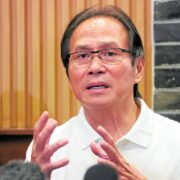Decentralizing development in the Philippines

Economic activity in the country remains highly concentrated in the Greater Capital Region (GCR), composed of the National Capital Region (NCR), Region III, and Region IV-A. In 2003, around 59 percent of the country’s gross domestic product (GDP) was from GCR, and in 2023, 57 percent of GDP still came from the same area.
Unsurprisingly, GCR’s poverty incidence, at 8.1 percent in the first quarter of 2023, is significantly lower than the 21.7 percent poverty incidence in regions outside of it.
Due largely to better employment opportunities and access to services, a quarter of the population has migrated from other regions to the wealthier GCR. Infrastructure is the most important factor affecting development gaps across regions.
A study published by the Philippine Institute for Development Studies shows that the NCR, Region IV-A, and Region III have the highest overall scores in their regional infrastructure development index while Bangsamoro Autonomous Region in Muslim Mindanao (BARMM), Region IX, and Region XII had the lowest overall scores. Gaps in the following are evident across regions:
Quantity and quality of roads. Road density, or the kilometers of roads available per 100 square km of land in GCR, exceeds the national average. More roads help reduce the cost and time of transporting goods and services, which boosts trade, attracts more businesses, and promotes economic growth.
The quality of roads is also important. Many regions need paved municipal roads, like Mimaropa and Region XI that have high unpaved percentages of 76.5 and 75.4 percent, respectively. Studies have shown that poverty is highly sensitive to road infrastructure, meaning that improving roads can greatly alleviate poverty in less-developed regions.
Access to electricity. Increased electricity access translates to a higher GDP. Almost all households in GCR have access to electricity but only 44.9 and 87.7 percent of households in BARMM and Region IX do. The cost of electricity in NCR is also relatively cheaper compared to other regions, another factor that draws more businesses to the capital.
Internet access. Latest government data show that 25.8, 18.8, and 17.6 percent of households in NCR, Region IV-A, and Region III have internet access but less than 5 percent of households in BARMM and Regions II, IV-B, VIII, IX, and XII have connectivity. This is alarming as internet access is necessary, from economic transactions to the education, reskilling, and upskilling of our labor force.
Closing these regional development gaps requires a combination of executive and legislative measures. Here are a few low-hanging fruits to consider:
Continue investing more than 4.5 percent of GDP on infrastructure, in line with the World Bank’s recommendation for developing countries. Engaging in more public-private partnerships (PPPs) is vital to achieve this as the Philippines has been underinvesting in infrastructure due to its limited fiscal space.
The possible gains from the recent enactment of the PPP code can be increased by removing foreign restrictions on land ownership for agricultural or business purposes. Similar to our Asean neighbors, our Congress, through a constitutional amendment, can allow foreigners to own only idle lands outside Metro Manila and other metropolitan areas to help generate more and better jobs outside the GCR.
Increase incentives for investing in less developed regions. Currently, projects or activities of registered enterprises located in areas recovering from armed conflict or a major disaster are granted an additional two years of income tax holidays to help such areas recover. By amending the Corporate Recovery and Tax Incentives for Enterprises Act, this incentive can be extended to enterprises in less developed regions to encourage more investments and boost economic activity.
Continuously improve the ease of doing business. The integration of the Energy Regulatory Commission’s systems into the Energy Virtual One-Stop Shop (EVOSS) is a good first step.
However, the average time for regulatory approval of energy transmission projects remains very long at 410 calendar days despite the EVOSS promise of providing such within 270 days from application.
Pass the Open Access in Data Transmission bill, which will improve internet access by lowering barriers to entry and investment and encouraging competition. The bill’s provisions include the removal of the legislative franchise requirement for internet infrastructure deployment which would simplify the licensing process for internet providers.
Since investors are naturally expected to invest in regions with high levels of economic activity, effective government intervention is necessary to achieve a more balanced economic development while mitigating the migration of people from the provinces to the GCR.
Only through a sustained and coordinated strategy that combines infrastructure development and targeted incentives can we ensure sustainable growth and equitable development that benefits all regions and every Filipino.
Gary B. Teves served as finance secretary under the Arroyo administration.

















